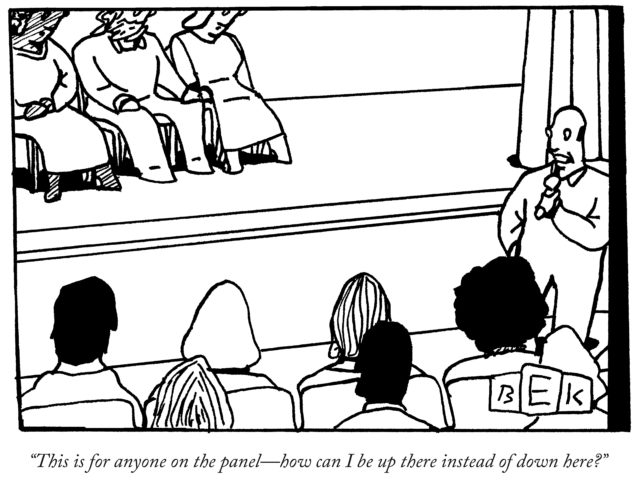Ask Me Anything About Conference Panels—Annotated Video
I guarantee you will learn many new great ideas about conference panels from this Blab of my Thursday chat with the wonderful Kristin Arnold. I’ve annotated it so you can jump to the good bits . (But it’s pretty much all good bits, so you may find yourself watching the whole thing. Scroll down the whole list; there are many advice gems, excellent stories and parables, folks show up at our homes, Kristin sings, etc.!) With many thanks to Kristin and our viewers (especially Kiki L’Italien who contributed mightily) I now offer you the AMA About Conference Panels annotated time-line.
[Before I turned on recording] We talked about: what panels are and aren’t; the jobs of a moderator; panel design issues; some panel formats; and our favorite panel size (Kristin and I agree on 3).
[0:00] Types of moderator questions.
[1:30] Using sli.do to crowdsource audience questions.
[2:40] Panel moderator toolboxes. One of Kristin’s favorite tools: The Newlywed Game. “What word pops into your mind when you think of [panel topic]?”
[4:30] Audience interaction, bringing audience members up to have a conversation; The Empty Chair.
[6:00] Preparing panelists for the panel.
[9:10] Other kinds of panel formats: Hot Seat, controversial topics.
[12:00] Continuum/human spectrograms/body voting and how to incorporate into panels.
[13:50] Panelist selection.
[14:40] Asking panelists for three messages.
[16:30] How the quality of a moderator affects the entire panel.
[17:30] More on choosing panelists.
[18:30] How to provoke memorable moments during panels; Kristin gives two examples involving “bacon” and “flaw-some“.
[20:30] Panelist homework. Memorable phrases: “The phrase that pays“; Sally Hogshead example.
[23:00] Panelists asking for help. Making them look good.
[24:10] Warming up the audience. The fishbowl sandwich: using pair-share as a fishbowl opener.
[25:30] Other ways to warm up an audience: pre-panel mingling, questions on the wall, striking room sets.
[26:30] Meetings in the round.
[28:00] Kristin’s book “Powerful Panels“, plus a new book she’s writing.
[29:00] Pre-panel preparation—things to do when you arrive at the venue.
[30:00] Considerations when the moderator is in the audience.
[31:00] Panelist chairs: favorite types and a clever thing to do to make panelists feel really special.
[32:50] Where should the moderator be during the panel? Lots of options and details.
[36:20] A story about seating dynamics from the late, great moderator Warren Evans.
[37:50] The moderator as consultant.
[38:40] Goldilocks chairs.
[39:40] Adrian explains the three things you need to know to set chairs optimally.
[41:00] “Stop letting the room set being decided for you,” says Adrian, while Kristin sees herself as more of a suggester.
[44:40] When being prescriptive about what you need is the way to go.
[46:30] Ideas about using screens at panel sessions.
[49:00] The UPS truck arrives at Adrian’s office door!
[50:00] Using talk show formats for panels: e.g. Sellin’ with Ellen (complete with blond wig.)
[52:20] Kristin’s gardener arrives!
[53:40] American Idol panel format.
[55:20] Oprah panel format.
[55:50] Control of panels; using Catchbox.
[56:20] Ground rules for the audience.
[59:10] What to say and do to get concise audience comments.
[1:00:00] A sad but informative story about a panelist who insisted on keeping talking.
[1:03:20] The Lone Ranger Fantasy.
[1:04:00] The moderator’s job, when done well, is pretty thankless.
[1:05:30] How you know if a panel is good. (Features mind meld between Kristin & Adrian!)
[1:06:10] The end of the fishbowl sandwich.
[1:07:40] Room set limitations caused by need to turn the room.
[1:10:00] Language: ground rules vs covenant; “Can we agree on a few things?”; standing to indicate agreement.
[1:13:00] You can’t please everyone.
[1:14:20] Kristin breaks into song!
[1:15:00] Non-obvious benefits obtained when you deal with an audience’s top issues.
[1:15:50] Why you should consider responding to unanswered attendee questions after the panel is over.
[1:16:40] The value (or lack of value) of evaluations.
[1:18:00] Following up on attendee commitments.
[1:20:00] Immediate evaluations don’t tell you anything about long term attendee change.
[1:21:10] “Panels are like a Wizard of Oz moment.”
[1:22:30] “Panels reframe the conversation in your head.”
[1:25:00] Kristin’s process that quickly captures her learning and future goals; her continuous improvement binder.
[1:26:40] Closing thoughts on the importance of panels, and goodbye.


 Ten minutes after I’d finished facilitating a large national association meeting hour-long fishbowl sandwich discussion on solutions for a persistent industry problem, the conference education director walked in. His jaw dropped. “The attendees are still here talking to each other! That never happens!” he exclaimed.
Ten minutes after I’d finished facilitating a large national association meeting hour-long fishbowl sandwich discussion on solutions for a persistent industry problem, the conference education director walked in. His jaw dropped. “The attendees are still here talking to each other! That never happens!” he exclaimed.